QuestionHello, my name is Leah Cho and I am an 8th grade student who is working on a science fair project relating with the consumption of rats. My main question is, "does a high sugar intake trigger weight gain and brain damage?", and I decided to experiment on rats with this.
I will have 6 rats 2 separate cages. 3 rats will be fed a high fructose sugar intake daily, and the 3 other rats will be fed a balanced diet. I will use foods that us humans eat. I asked this quesiton to another expert and she told me that also feeding rat blocks will be helpful. My hypothesis is that the rats fed with a high sugary fructose diet will gain more weight than those who have a well balanced diet of protein, carbs, and fruits/vegetables.
This is my plan:
Cage #1 (healthy diet)- (3 rats)
- Cooked brown rice
- Apples
- Carrots
- Eggs
Cage #2 (sugary diet)- (3 rats)
- Cornflake cereal
- Milk chocolate
- Sugary Yogurt
I will also give both cages rat blocks just to keep them alive, and ALSO including the human foods listed above.
I asked the other expert, and she told me that feeding them as much as they want is essential.
For 3 rats in one cage with the foods I listed above, what do you think is an ideal quantity of food to start off with?
To get an accurate result, I'm wondering if I should give them the same number of calories? Or the same number of grams?
Additionally, my prediction is that the ones who ate a high sugar diet would obviously turn out not having a good brain, so I will put them one by one in a tub of shallow water, and put a wooden block they must find to rescue themselves out of water to safety. My prediction is the ones who had a high sugar intake will not be able to figure out how to rescue themselves and therefore will struggle to get out of the water. Is it okay if these rats are in just room temperature water? Will it cause much damage?
Also for the cage, do you think I would be better off putting them in separate cages, as they might fight over the food and this might not go quite as planned? If so, just to be cheap do you think I would be able to make a cardboard cage? Or do you suggest I get an actual cage?
I will definitely incorporate water, the sipper water bottles would probably work fine I'm guessing?
PLEASE REPLY THIS IS VERY IMPORTANT TO ME!
THANK YOU VERY MUCH~ I am shocked with how helpful you all are!
AnswerHi Leah, I apologize for not responding any sooner. I have to tell you that I am not quite comfortable with using rats for a science experiment as the well being of these amazing creatures will be compromised. I do not condone this type of experiment.
Where are you obtaining your rats? What will you do with these 6 rats once your experiment concludes? I hope that you will choose to either keep them as pets or try to find good loving homes for them. I hope that you will not surrender them to a pet store, as they will surely be sold as snake food. Or surrender them to a rescue or shelter, as if homes are not found for them, they will be euthanized. Or post them on craigslist for free or a low cost, as they will surely be snatched up by a snake owner. I feel sorry for these rats as to their fate if you do anything other than keep and care for them yourself, or find proper homes.
Hesitantly, I will answer your questions. Yes, the rats with a high fat/sugar diet will not only gain weight, but they will be predisposed to diseases this type of diet can cause, including heart attack, stroke, pulmonary disease, cancer, tumors, and any number of diseases that humans can also develop from eating such a diet over many years.
You may think that since you will be conducting this experiment for only a few weeks that the rats system will not be affected negatively by it. Not true. Consider the average life of a rat is 2 years. Feeding this poor diet to a rat for a month is equivalent to a human eating this diet for 5 to 10 years. So you would be endangering their lives.
I do not know for certain if a high fat/sugar diet can cause brain damage. Personally, I would not take that risk on the innocent rats.
I do not recommend keeping the rats in an enclosure such as cardboard. They need a well ventilated living space....a cage.... as an enclosure will expose them to the ammonia odor from their urine, which is likely to cause respiratory disease. Even with a cage, I recommend changing their bedding twice a week at minimum to prevent illness. Since 3 rats will be living in each cage, the cage should have at least 2 levels and be a minimum of 18 inches wide by 12 inches long. Ideally, it should be 24 inches wide by 18 inches long, with 2 levels or more. The cages should have several cozy sleeping spaces such as hammocks, igloos, etc. As rats are very intelligent creatures, they get bored easily, so their cages should be enriched with things for them to do. Include a wheel in each cage, and perhaps chew toys that are safe (made for rats). Throw in some small boxes such as tissue boxes for them to chew or hang out inside. Pieces of paper, paper towels, cardboard will give them things to shred and chew and make nest or mountains out of. They need to be kept enriched and busy, especially if they are females.
A water bottle is fine, but it should be checked daily to make sure the water is flowing, as they can sometimes get clogged.
I would not keep each rat in its own separate cage as that would stress them. Rats are social creatures and do best when in groups.
The amount of food given per day should be about the size of a rat's head...that amount per rat in the cage. I would suggest keeping a bowl of blocks in the cage at all times so they can graze throughout the day and night. I suggest giving the experiment food once a day...again, the size of 3 rats' heads per cage. They will share the food. They may stash it throughout the cage, but rats are good at searching and finding stashed food.
As far as the healthy diet, rats should have a VERY low fat and low protein diet, and free of salt. I recommend eggs or another healthy protein only 2x per week. Rice or pasta or whole grain bread or cereal for variety as your carb is fine every day. Apples and carrots are fine but not NEARLY enough of a variety. You should mix it up by including peas, broccoli, blueberries, raspberries, bananas, grapes, and other fruits and veggies. You can add cooked or canned rinsed beans as well, best choices being garbanzo, kidney and black beans.
For your water rescue experiment, the water should be a little warmer than room temp, comfortable to the touch. Although rats are natural swimmers, some may not be able to as they may panic. Therefore, do not make the water deep. I suggest about 2 inches deep so that they can keep their heads above the water. Be prepared that being placed in the water will cause them stress. Expect that out of fear, they will defacate into the water so be prepared to scoop the poops out.
I hope that you will treat these rats as if they were members of your own family, treating them humanely during this process as well as afterwards, as I discussed above.

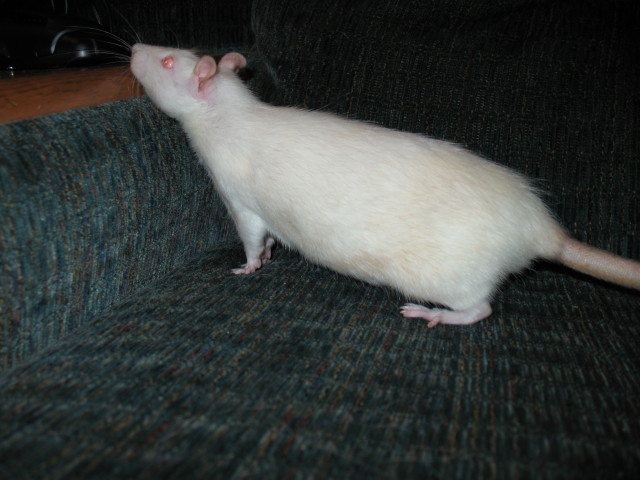 I dont know what she has!
QuestionQUESTION: Hello Sandra,
I recently helped take
I dont know what she has!
QuestionQUESTION: Hello Sandra,
I recently helped take
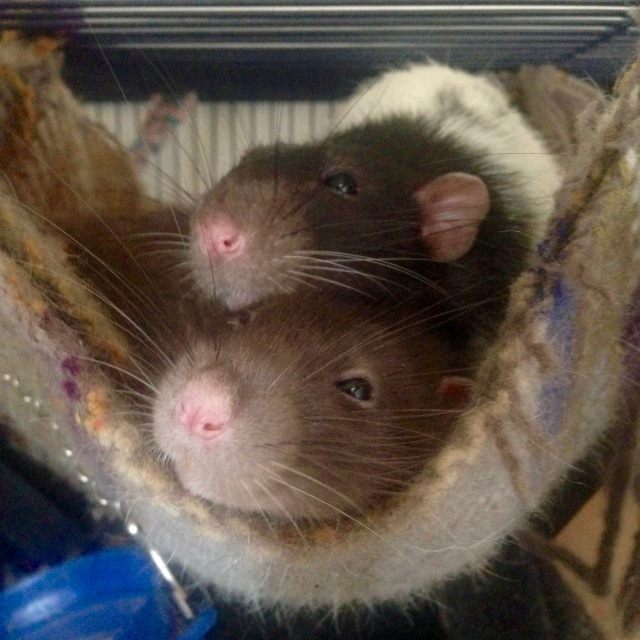 Respiratory infection
Question
John&Stevie
Yesterday I noticed my
Respiratory infection
Question
John&Stevie
Yesterday I noticed my
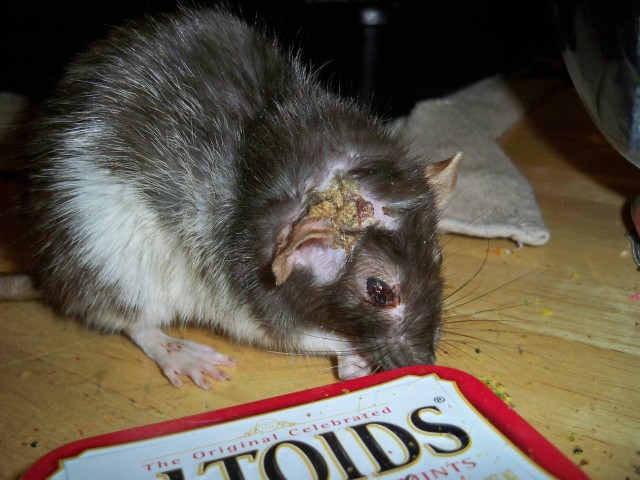 Large head wound
QuestionQUESTION: Hello,
You recently posted a questio
Large head wound
QuestionQUESTION: Hello,
You recently posted a questio
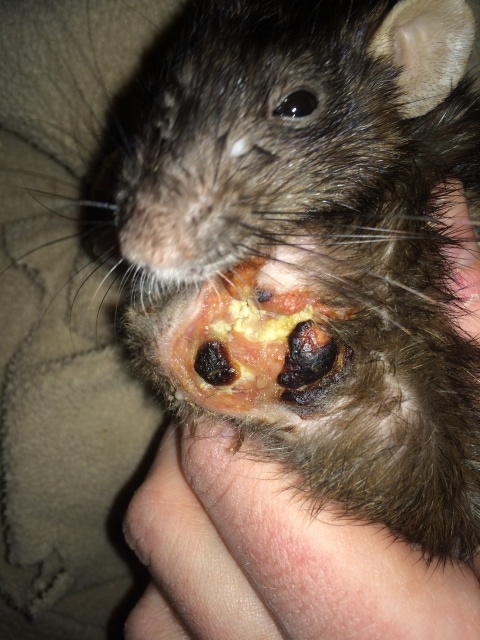 Older sick rat with abcessed tumor
QuestionQUESTION: Hello Debbie,
I have had 7 rats the
Older sick rat with abcessed tumor
QuestionQUESTION: Hello Debbie,
I have had 7 rats the
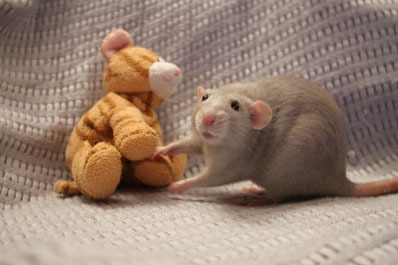 now not drinking or eating at all
Question
QUESTION: hi Sandy
I have a ratty quest
now not drinking or eating at all
Question
QUESTION: hi Sandy
I have a ratty quest